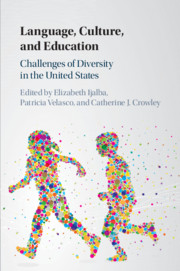Book contents
- Language, Culture, and Education
- Language, Culture, and Education
- Copyright page
- Dedication
- Contents
- Figures
- Tables
- Contributors
- Expanding Language and Ability Difference: A Foreword
- Acknowledgments
- Introduction to the Immigrant Experience
- Part I Immigration, Bilingual Education, Policy, and Educational Planning
- Part II Bilingualism, Literacy Ecologies, and Parental Engagement among Immigrant Families
- Part III Cultural Perceptions about Disability, the Home Language, and Healthcare Alternatives among Immigrants
- 10 Perceptions about Autism in Hispanic Immigrant Mothers of Preschool Children with Autism Spectrum Disorders
- 11 How Early Childhood Interventions Endanger the Home Language and Home Culture: A Call to Value the Role of Families
- 12 A Critical Review of Cultural and Linguistic Guidelines in Serving Arab-Americans
- 13 Building Home–School Connections within a Multicultural Education Framework: Challenges and Opportunities before and after President Trump’s Election
- 14 Health and Alternatives to Healthcare for Mexican Immigrants in New York
- Epilogue
- References
- Index
12 - A Critical Review of Cultural and Linguistic Guidelines in Serving Arab-Americans
from Part III - Cultural Perceptions about Disability, the Home Language, and Healthcare Alternatives among Immigrants
Published online by Cambridge University Press: 11 March 2019
- Language, Culture, and Education
- Language, Culture, and Education
- Copyright page
- Dedication
- Contents
- Figures
- Tables
- Contributors
- Expanding Language and Ability Difference: A Foreword
- Acknowledgments
- Introduction to the Immigrant Experience
- Part I Immigration, Bilingual Education, Policy, and Educational Planning
- Part II Bilingualism, Literacy Ecologies, and Parental Engagement among Immigrant Families
- Part III Cultural Perceptions about Disability, the Home Language, and Healthcare Alternatives among Immigrants
- 10 Perceptions about Autism in Hispanic Immigrant Mothers of Preschool Children with Autism Spectrum Disorders
- 11 How Early Childhood Interventions Endanger the Home Language and Home Culture: A Call to Value the Role of Families
- 12 A Critical Review of Cultural and Linguistic Guidelines in Serving Arab-Americans
- 13 Building Home–School Connections within a Multicultural Education Framework: Challenges and Opportunities before and after President Trump’s Election
- 14 Health and Alternatives to Healthcare for Mexican Immigrants in New York
- Epilogue
- References
- Index
Summary
- Type
- Chapter
- Information
- Language, Culture, and EducationChallenges of Diversity in the United States, pp. 207 - 225Publisher: Cambridge University PressPrint publication year: 2019



